Confidence over Capital: Indian Banks fare better
Mutual Fund
Introduction
The month of March 2023 saw a slew of US regional banks facing a crises of confidence resulting in panic across respective deposit bases and ultimately a collapse of some banks. The situation was compounded as Credit Suisse, one of the world’s largest banks was hastily forced into a takeover deal by the Swiss National Bank (Swiss Bank regulator) with counterpart UBS.
The collapse was distinctive as compared to precursor systemic events or shortcomings in the global banking industry that caused the Great financial crisis (GFC) in 2008. The banks’ balance sheet structure and more significantly its deposit base, as well as poor regulatory oversight, were all significant factors in their demise.
In the Indian context, we believe, robust Asset Liability Management (ALM) guidelines, strong regulatory frameworks and government guarantees make a similar situation unlikely. Further banks and financial institutions in India have significant capital buffers and provision coverage ratios to tide over liquidity issues.
It is important to stress that portfolios of schemes of Axis MF (Including fund of funds) do not have any exposure to Silver gate bank, Silicon Valley Bank, Credit Suisse Signature Bank & First Republic Bank.
Macro-Economic Backdrop – Probable causes of the Panic & Collapse
The Crises of 2023 differs from GFC 2008 on 3 fronts.
- Global macro-economic conditions are significantly different
- Crises of confidence in the banking sector, not asset failures
- Prompt central bank actions mitigate contagion risks
Global macro-economic conditions are significantly different
The global macro environment has changed materially since the 2007 crisis. The US and Europe today account for a much smaller portion of the global GDP as compared to Asia. To put things in perspective, China today contributes ~19% of the worldwide GDP, compared to just 11% during the GFC. Further, unlike in 2007, the crisis of 2023 has been largely isolated to specific regions and institutions.
Developed economies saw a more prolonged downturn than emerging markets(EMs) due to matured financial markets and more exposure to instruments like asset backed securities. Correlations across economies have also improved as a result of a global delinking brought on by the COVID lockdowns. This is evident from cross national data (China had entered a COVID-induced slowdown in H1 2022 when other economies like the UK and India showed strong growth). Global GDP, likely to see below-trend growth in 2023, will get some breathing space from China's reopening.
Interest rates have also seen a sudden sharp surge in interest rates across the world with benchmark rates in the US spiking 400bps over the last year. European rates have also risen 250 bps.
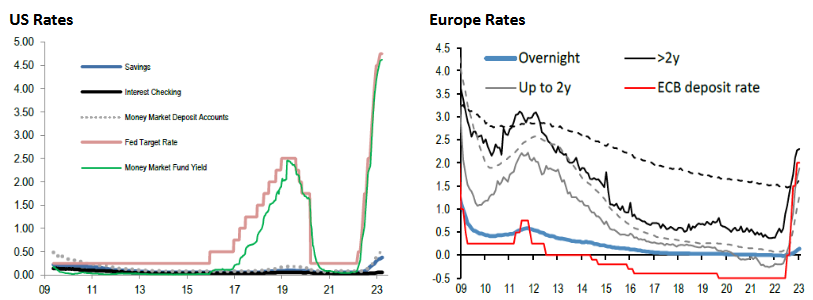
Source: US Federal Reserve, European Central Bank. Data as of 24th March 2023.
The above graph is used to explain the concept and is for illustration purpose only and should not be used for development or implementation of an investment strategy. Past performance may or may not be sustained in future.
Crises of Confidence – Credibility more important than just capital adequacy
These recent events again underscore importance of trust and credibility as key for financial institutions, rather than just reported financials. Both SVB (15% CET-1) and Credit Suisse (20% (CET-1 + AT-1), 39.5% including all bail-in debt) reported capital levels were well above traditional comfort thresholds. Leverage ratio for SVB was 13 times and CS 12 times in 2022, compared to Lehman that had 30 times in 2007. However, as concerns on these banks mounted, accelerated deposit outflows forced regulators to step-in
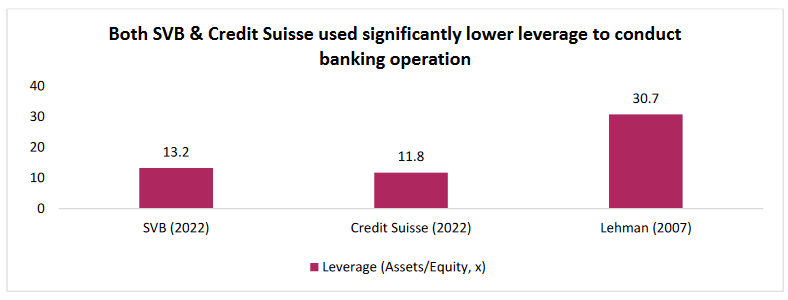
Source: Annual Reports, Axis MF Research. Data as on last available basis used for comparative purposes
The above graph is used to explain the concept and is for illustration purpose only and should not be used for development or implementation of an investment strategy. Past performance may or may not be sustained in future. The Stocks mentioned above are used to explain the concept and is for illustration purpose only and should not be used for development or implementation of any investment strategy. It should not be construed as investment advice to any party. The stocks may or may not be part of our portfolio/strategy/ schemes. Past performance may or may not be sustained in future.
Prompt central bank actions mitigate contagion risks
Central bank actions have been prompt. Global financial system has been shaken up in the last few weeks. In a revisit of the GFC investor and depositor confidence on banks have taken a hit, leading to unprecedented deposit withdrawals in impacted banks. Global central bank action this time though has been swift, as in the US FDIC guaranteeing deposits to prevent further spread of panic. In Europe, the SNB also pushed a merger of Credit Suisse with UBS, as the former witnessed deposit withdrawals and spike in credit spreads.
These timely reassurances from central banks should aid calm returning to markets, though outlook on global growth and inflation remain continuing concerns.
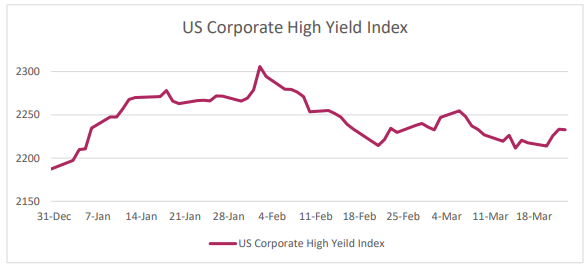
Source: Bloomberg, Axis MF Research. Data as of 23rd March 2023
The above graph is used to explain the concept and is for illustration purpose only and should not be used for development or implementation of an investment strategy. Past performance may or may not be sustained in future
Indian Financial System – Better Insulated from Liquidity Shocks
Retail funding of Indian Banks provide comfort: Indian Banking system has been largely insulated from this volatility with consistent deposit flows. Banks have emerged stronger post the NPA cycle of the past decade, NPAs are now 5% down from a peak of 11.5%. Regulatory tightening has also helped liquidity parameters improve and LCRs are now 140% vs 125% 5 years ago (Source: Annual financial reports).
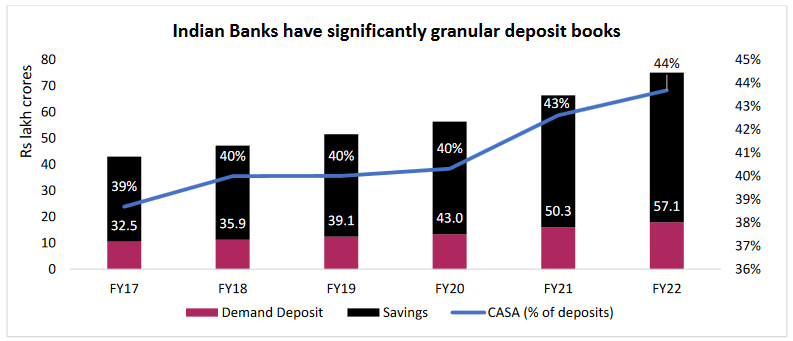
Source: RBI, Axis MF Research. Data as of 24th March 2023
The above graph is used to explain the concept and is for illustration purpose only and should not be used for development or implementation of an investment strategy. Past performance may or may not be sustained in future.
Indian banks are also primarily retail funded. Of the overall banking system deposits of Rs. 172 lakh crores, ~49% of the same is made up from small and retail depositors, with balance less than Rs 5 lakhs. All deposits up to Rs 5 lakh are insured by the DICGC. In US as well FDIC insured $9.9 trillion of deposits as of Sep-22, covering ~55% of total deposits.
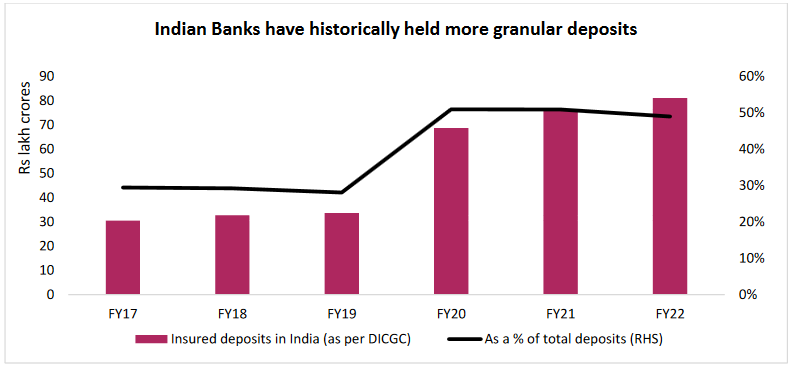
Source: RBI, DICGC, Axis MF Research. Data as of March 31st 2022
The above graph is used to explain the concept and is for illustration purpose only and should not be used for development or implementation of an investment strategy. Past performance may or may not be sustained in future.
MTM risk manifests only if coupled with ALM/interest rate mismatch
Mark to market risk on bank balance sheets has also come into focus given it was the catalyst for SVB and the policy rate hike cycles underway globally. Indian banks also have about 24% of their assets in government bonds, largely due to mandated regulatory reserve requirements.
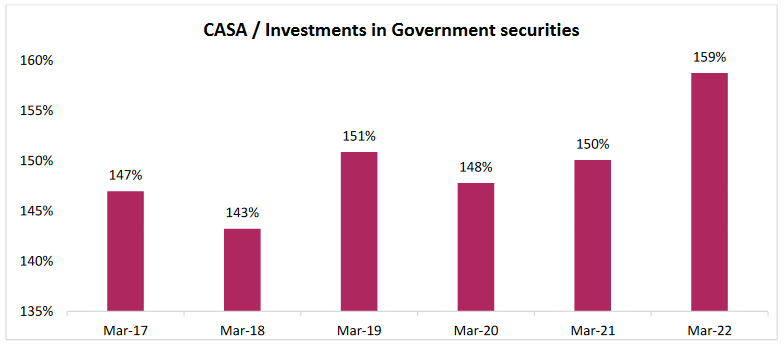
Source: RBI, DICGC, Axis MF Research. Data as of March 31st 2022
The above graph is used to explain the concept and is for illustration purpose only andshould not be used for development or implementation of an investment strategy. Past performance may or may not be sustained in future.
Mark down on bond portfolios though pushes up the future yields on the portfolio (as cash flow from the bond is unchanged). Say, if a 7% coupon bond bought at Rs100, is marked down to Rs 90 due to rise in rates. In this case, the yield on the investment will rise to 7.8% once the investment is marked down. Therefore, the true risk of a bond investment manifests only if there is an asset-liability mismatch (bank is forced to sell bond to meet obligations) or an interest mismatch (banks cost of fund also increases therefore the higher yield does not translate to higher margins).
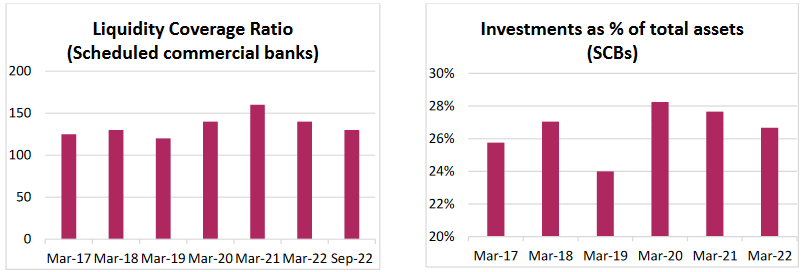
Source: RBI, DICGC, Axis MF Research. Data as of December 31st 2022
The above graph is used to explain the concept and is for illustration purpose only and should not be used for development or implementation of an investment strategy. Past performance may or may not be sustained in future.
Portfolio Update
In terms of existing financials holdings, we remain comfortable with our positions. The team has been mindful of the strength of bank funding positions including the quality of deposit franchises (i.e. a strong retail current account franchise) and superior credit risk outcomes.
Our portfolios have consistently better risk outcomes, high confidence, resulting in higher multiples
As capital allocators, we focus on certain key aspects that increases defensibility and longevity of businesses. Emphasis on quality, credibility translates to lower GNPA trends for the stocks in our investment universe, which tracks better than overall sector trends.
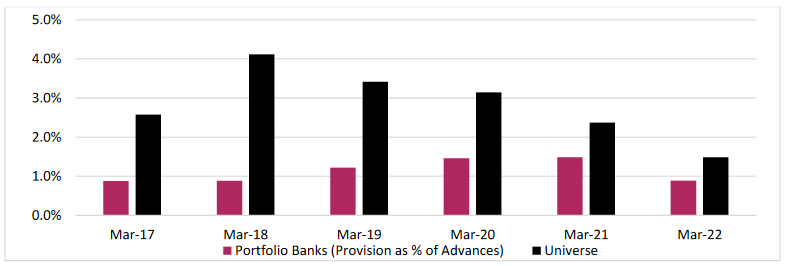
Source: Axis MF Research, Data as of 31st December 2022. Portfolio banks and universe include equity holdings across all Axis Mutual Fund schemes and those part of the AMC research universe. Stocks/sectors mentioned are illustrative and data contained in this document is not to be treated as research advice.
About the Author
Ashish Gupta
CIO – Axis AMC
Mr. Ashish Gupta joined Axis AMC in March 2023 as the Chief Investment Officer for Axis Mutual Fund. He is responsible for developing, communicating and driving the investment strategy across all product segments of the fund house.
Ashish has a rich experience of 25 years across varied industries. His last stint was with Credit Suisse as the Head of India (Equity Research) where he actively tracked the Banking sector in 13 Asian economies. He has a strong understanding of global & regional macroeconomics and began his professional journey with IDBI.
Ashish was one of the earliest to identify the asset quality cycle in Indian Banks in 2011 and authored several marquee reports including the “House of Debt” series.
Disclaimer
This document represents the views of Axis Asset Management Co. Ltd. and must not be taken as the basis for an investment decision. Neither Axis Mutual Fund, Axis Mutual Fund Trustee Limited nor Axis Asset Management Company Limited, its Directors or associates shall be liable for any damages including lost revenue or lost profits that may arise from the use of the information contained herein. No representation or warranty is made as to the accuracy, completeness or fairness of the information and opinions contained herein. The material is prepared for general communication and should not be treated as research report. The data used in this material is obtained by Axis AMC from the sources which it considers reliable.
While utmost care has been exercised while preparing this document, Axis AMC does not warrant the completeness or accuracy of the information and disclaims all liabilities, losses and damages arising out of the use of this information. Investors are requested to consult their financial, tax and other advisors before taking any investment decision(s). The AMC reserves the right to make modifications and alterations to this statement as may be required from time to time.
Statutory Details: Axis Mutual Fund has been established as a Trust under the Indian Trusts Act, 1882, sponsored by Axis Bank Ltd. (liability restricted to Rs. 1 Lakh). Trustee: Axis Mutual Fund Trustee Ltd. Investment Manager: Axis Asset Management Co. Ltd. (the AMC) Risk Factors: Axis Bank Limited is not liable or responsible for any loss or shortfall resulting from the operation of the scheme.
(Mutual Fund investments are subject to market risks, read all scheme related documents carefully.)
MUTUAL FUND TOOLS & CALCULATORS
Recent News
-
The Wealth Company Mutual Fund Receives SEBI Approval to Launch Specialized Investment Fund SIF
Nov 26, 2025
-
Axis Mutual Fund Launches Axis Multi Asset Active FoF Fund of Fund: A One Stop Solution for Dynamic Asset Allocation
Nov 21, 2025
-
The Wealth Company Mutual Fund makes record debut with four active NFOs, garners close to Rs 2000CR
Oct 29, 2025
-
Axis MF Launches Axis Income Plus Arbitrage Passive FOF
Oct 28, 2025
-
Aditya Birla Sun Life AMC Press Release Q2 FY26 Final
Oct 28, 2025







